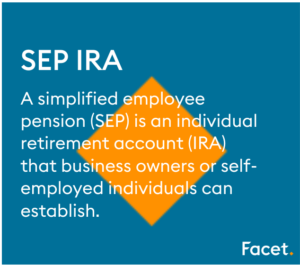
The information provided is based on the published date.
Key takeaways
- SEP IRAs are tax deferred accounts designed for business owners and self-employed individuals with higher contribution limits than a traditional IRA
- SEPs can be opened at most financial institutions; investments may include stocks, bonds, CDs, ETFs and mutual funds
- Contributions are tax deductible for employers; employees pay taxes on retirement withdrawals
- Unlike a Roth IRA, SEPs provide tax-deferred growth but do not offer tax free withdrawals
- A solo 401(k) offers quicker savings but has similar contribution limits as a SEP
What is a SEP IRA?
A simplified employee pension (SEP) individual retirement account (IRA) is fundamentally very similar to a traditional IRA: contributions are tax deductible, and investments grow tax-deferred until retirement withdrawals commence. However, the main differentiator for SEP IRAs is that they are specifically designed for business owners and have higher contribution limits.
Who is eligible for a SEP IRA?
Self-employed individuals and small business owners with no or just a few employees are best suited for a SEP IRA plan. The reason: The IRS includes eligible employees as participants in your plan, which means you must contribute an equal percentage to your own compensation on their behalf.
What this means is that if you wish to squirrel away 20% of your paycheck into your SEP plan, you must also contribute 20% to your employee's SEP IRA.
IRS eligible participant rules for 2023
Eligible employees must be at least 21, employed (by you) for at least 3 of the previous 5 years, and earned at least $750. Employees have full ownership and control of their accounts.

How much can I contribute to a SEP IRA in 2023?
In 2023, the IRS allows you to contribute up to $66,000 to a SEP IRA account, assuming your annual contributions don't go over the lesser of the following two limits:
- 25% of your total income, up to $330,000
- $66,000
The 25% rule is the same for each eligible employee.
How to open a SEP IRA
Opening a SEP IRA is usually as simple as filling out some paperwork at your chosen financial institution. However, you'll need to ensure the plan allows for SEP contributions. You'll also need to confirm they support the investment options you wish to hold in your SEP account. Your financial advisor can set up a plan for you.
Can I contribute to other retirement accounts if I have a SEP IRA?
The IRS allows you to contribute to other retirement accounts even if you have a SEP IRA. However, contribution limits may vary depending on the type of account and your income level. It's best to consult a financial advisor to determine the best strategy for your circumstances.
Related: Top 4 retirement plan options for small business owners
What investment options are offered?
SEP IRAs typically offer a range of investment options, including stocks, bonds, CDs, exchange-traded funds (ETFs), mutual funds, and more. Researching and choosing investments that align with your long-term financial goals and risk tolerance is essential.
How are taxes handled with a SEP IRA?
Contributions to a SEP IRA are tax-deductible for the employer, which can help lower their taxable income. Employees are responsible for paying taxes on withdrawals made during retirement, much like traditional IRAs.
What's the difference between a Roth IRA and a SEP IRA?
Both a SEP IRA and a Roth IRA provide tax benefits. The key distinction is that SEP IRAs offer tax-deferred growth on investments, while Roth IRAs provide tax-free growth and withdrawals during retirement.
Contributions to SEP IRAs are tax deductible. Unlike Roth accounts, you can include employees in a SEP IRA and make contributions for them. This makes SEP IRAs a more popular choice for self-employed individuals.
SEP IRAs have higher contribution limits (up to $66,000 in 2023) compared to Roth IRAs ($6,500 in 2023). Both accounts are suitable for business owners but offer different tax advantages.
Which is better for business owners, a SEP IRA or a solo 401(k)?
It's a case-by-case basis: The answer depends on each business owner's specific needs and circumstances.
Despite similar contribution limits, the solo 401(k) enables quicker savings. The SEP IRA allows you to save 25% of your income, while the solo 401(k) allows up to 100% as employee contributions (up to the annual threshold) with the option to switch to employer contributions at a 25% rate.
Advantages and disadvantages of a SEP IRA
Advantages
- Inexpensive and straightforward to set up and maintain
- High contribution limits
- Tax-deferred growth on investments
- Contributions are tax-deductible
Disadvantages
- Must contribute for all eligible employees, not just yourself
- Limited options for early withdrawals without penalty
- Required minimum distributions (RMDs) starting at age 72
Final word
SEP IRAs can be a solid retirement savings vehicle for self-employed individuals and small business owners looking to save for retirement while also providing employee benefits. However, it's essential to carefully consider your specific needs and circumstances before deciding on a retirement plan.
Consulting a trusted financial advisor can help you make the best decision for your future financial objectives. They can guide you through the process and help determine the best retirement plan for your situation.
Simplify your financial life. Facet offers personalized financial planning and advice to help you make the most of every dollar you earn. Our team of experts will guide you through the process and tailor a plan to fit your individual needs. We will help you make the best decisions for your financial future. Get started today and take control of your finances with Facet.
Facet
Facet Wealth, Inc. (“Facet”) is an SEC registered investment adviser headquartered in Baltimore, Maryland. This is not an offer to sell securities or the solicitation of an offer to purchase securities. This is not investment, financial, legal, or tax advice. Past performance is not a guarantee of future performance.


